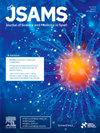Repeatability, reproducibility and normative ranges for EyeGuide Focus testing system in elite male rugby players
IF 3
2区 医学
Q1 SPORT SCIENCES
引用次数: 0
Abstract
Objectives
The EyeGuide Focus system is a simple, portable, test of visual tracking with potential use for concussion screening. This study investigated the repeatability, reproducibility, distribution, and modifiers of EyeGuide Focus measurements in healthy elite Rugby players.
Design
Cross sectional repeated measures study and controlled pre-test post-test sub-study.
Methods
EyeGuide Focus testing was performed in a medical room at rest. Test-retest repeatability (within-subject standard deviation (Sw), coefficient of variation (CV), repeatability coefficient (RC)) and reliability intra-class correlation coefficient (ICC A,1) of 3 test results were evaluated. The distribution of best score across replicates was then examined using summary statistics, and the influence of subject characteristics investigated. A controlled pre-test post-test sub-study examined the effect of exercise on best EyeGuide Focus score using an analysis of covariance (ANCOVA).
Results
A total of 769 elite male Rugby players underwent EyeGuide Focus testing. Repeated test scores demonstrated positively skewed distributions. Test-retest repeatability (Sw 1.46, CV 46.0 %, RC 2.85, natural log transformed data) and reliability (ICC 0.41, natural log transformed data) were low. The distribution of best EyeGuide Focus score was unaffected by previous concussion, eye conditions, or age. No learning or exercise effects were apparent in the controlled pre-test post-test sub-study (ANCOVA, n = 89, p = 0.69).
Conclusions
EyeGuide Focus test-retest repeatability and reliability were low and could limit diagnostic accuracy.
Best test score achieved across repeated measurements is a possible metric for operationalisation and future research is required to determine if this differs in patients with concussion compared to normal subjects.
精英男子橄榄球运动员EyeGuide焦点测试系统的可重复性、再现性和规范范围。
目的:EyeGuide聚焦系统是一种简单、便携的视觉跟踪测试,具有脑震荡筛查的潜在用途。本研究调查了健康精英橄榄球运动员的EyeGuide焦点测量的可重复性、再现性、分布和修饰因素。设计:横断面重复测量研究和对照测试前测试后子研究。方法:眼导聚焦试验在静息室进行。对3个试验结果的重测可重复性(受试者内标准差(Sw)、变异系数(CV)、可重复性系数(RC)和信度类内相关系数(ICC A,1)进行评价。然后使用汇总统计检验最佳分数在重复中的分布,并研究受试者特征的影响。一项对照测试前测试后测试子研究使用协方差分析(ANCOVA)检验了运动对最佳EyeGuide Focus得分的影响。结果:共有769名优秀橄榄球男运动员接受了EyeGuide Focus测试。重复测试成绩显示正偏态分布。重测重复性(Sw 1.46, CV 46.0 %,RC 2.85,自然对数转换数据)和可靠性(ICC 0.41,自然对数转换数据)较低。最佳EyeGuide Focus评分的分布不受先前脑震荡、眼部状况或年龄的影响。在对照的前测后测子研究中,学习或运动没有明显的影响(ANCOVA, n = 89,p = 0.69)。结论:EyeGuide Focus test-retest重复性和可靠性较低,限制了诊断的准确性。在重复测量中获得的最佳测试分数是操作的可能指标,需要未来的研究来确定脑震荡患者与正常受试者相比是否有所不同。
本文章由计算机程序翻译,如有差异,请以英文原文为准。
求助全文
约1分钟内获得全文
求助全文
来源期刊
CiteScore
7.40
自引率
10.00%
发文量
198
审稿时长
48 days
期刊介绍:
The Journal of Science and Medicine in Sport is the official journal of Sports Medicine Australia (SMA) and is an an international refereed research publication covering all aspects of sport science and medicine.
The Journal considers for publication Original research and Review papers in the sub-disciplines relating generally to the broad sports medicine and sports science fields: sports medicine, sports injury (including injury epidemiology and injury prevention), physiotherapy, podiatry, physical activity and health, sports science, biomechanics, exercise physiology, motor control and learning, sport and exercise psychology, sports nutrition, public health (as relevant to sport and exercise), and rehabilitation and injury management. Manuscripts with an interdisciplinary perspective with specific applications to sport and exercise and its interaction with health will also be considered.

 求助内容:
求助内容: 应助结果提醒方式:
应助结果提醒方式:


